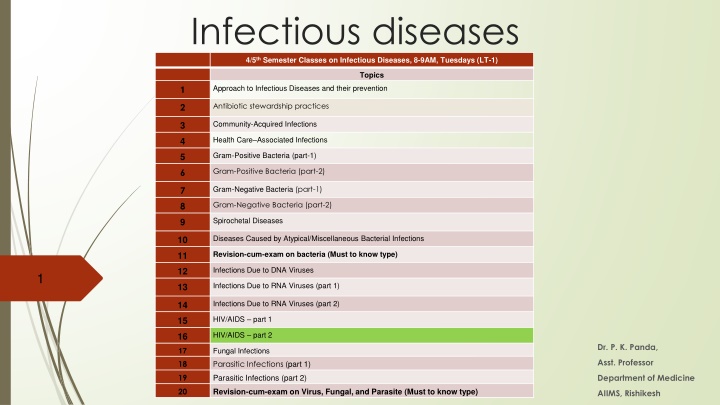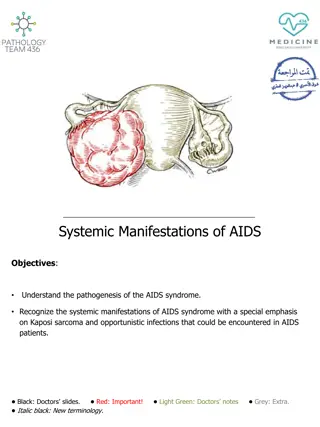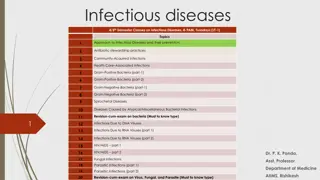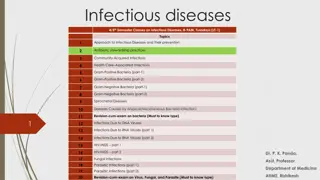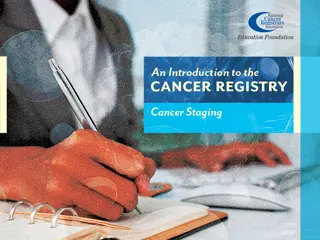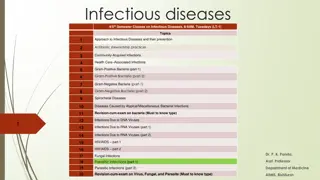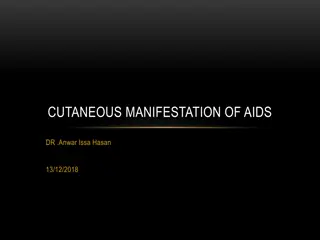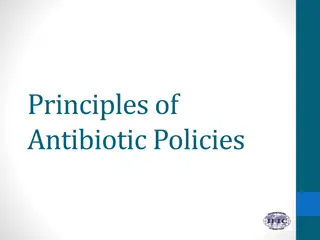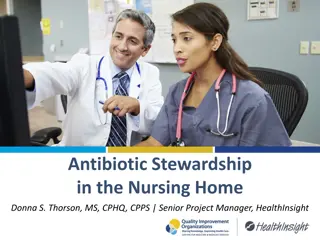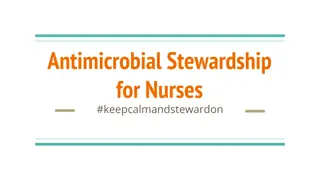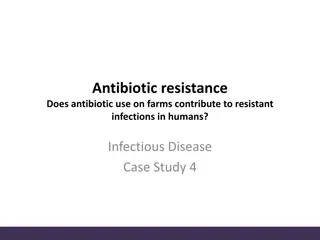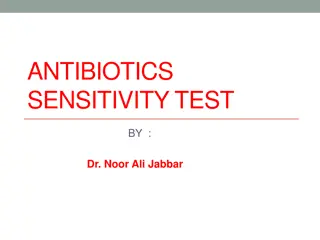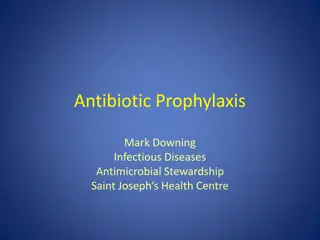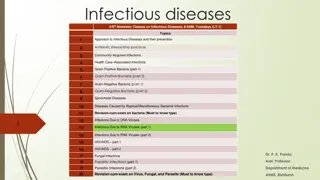Approach to Infectious Diseases: Antibiotic Stewardship, Bacterial Infections, and HIV/AIDS Clinical Staging
In the 4th-5th semester classes on infectious diseases, topics such as antibiotic stewardship, community-acquired infections, and various bacterial diseases are covered. The clinical manifestations and WHO clinical staging of HIV/AIDS for adults and adolescents are also discussed in detail. The course emphasizes understanding different infectious diseases, prevention strategies, and the stages of HIV infection progression.
Download Presentation

Please find below an Image/Link to download the presentation.
The content on the website is provided AS IS for your information and personal use only. It may not be sold, licensed, or shared on other websites without obtaining consent from the author.If you encounter any issues during the download, it is possible that the publisher has removed the file from their server.
You are allowed to download the files provided on this website for personal or commercial use, subject to the condition that they are used lawfully. All files are the property of their respective owners.
The content on the website is provided AS IS for your information and personal use only. It may not be sold, licensed, or shared on other websites without obtaining consent from the author.
E N D
Presentation Transcript
Infectious diseases 4/5thSemester Classes on Infectious Diseases, 8-9AM, Tuesdays (LT-1) Topics Approach to Infectious Diseases and their prevention 1 Antibiotic stewardship practices 2 Community-Acquired Infections 3 Health Care Associated Infections 4 Gram-Positive Bacteria (part-1) 5 Gram-Positive Bacteria (part-2) 6 Gram-Negative Bacteria (part-1) 7 Gram-Negative Bacteria (part-2) 8 Spirochetal Diseases 9 Diseases Caused by Atypical/Miscellaneous Bacterial Infections 10 Revision-cum-exam on bacteria (Must to know type) 11 Infections Due to DNA Viruses 12 1 Infections Due to RNA Viruses (part 1) 13 Infections Due to RNA Viruses (part 2) 14 HIV/AIDS part 1 15 HIV/AIDS part 2 16 Dr. P. K. Panda, Fungal Infections Parasitic Infections (part 1) 17 18 Asst. Professor Department of Medicine 19 Parasitic Infections (part 2) 20 Revision-cum-exam on Virus, Fungal, and Parasite (Must to know type) AIIMS, Rishikesh
ClinicalManifestations The center for disease control (CDC) has classified the clinical course of HIV infection under various groups. 1. Acute HIVinfection 2. Asymptomatic or Latent infection 3. Persistent generalized lymphadenopathy (PGL) 4. AIDS relatedcomplex 5. Full blown AIDS (Laststage)
WHO clinical staging of HIV/AIDS for adults & adolescents2010 Clinical Stage1 Asymptomatic Persistent generalized lumphadenopathy Clinical Stage2 Unexplained moderate weight loss (<10% of presumed or measured body weight) Recurrent respiratory tract infections (sinusitis, tonsillitis, otitis media, pharyngitis) Herpeszoster Angular Cheilitis Recurrent oral ulceration Papular pruriticeruptions Seborrhoeic dermatitis Fungal nail infections Clinical Stage3 Unexplained 2 servere weight loss (>10% of presumed or measured body weight) Unexplained chronic diarrhoea for longer than oneonth Unexplainedpersistentfever(above37.5OCintermittentorconstantforlongerthanone month) Persistent oralcandidiais Oral hairy leukoplakia Pulmonary tuberculosis Severe bacterial infections (e.g. pneumonia, empyema, pyomyositis, bone or joint infection, meningitis,bacteraemia) Acute necrotizing ulcerative stomatitis, gingivitis orperiodontitis Unexplained anaemia (<8 g/dl), neutropenia (<0.5 x 109/litre) and or chronic thrombocytopenia (<50 x109/litre3) Clinical stage43 HIV wasting syndrome Pneumocystis pneumonia Recurrent severe bacterialpneumonia Chronic herpes simplex infection (orolabial, genital or anorectal ofmore than one month s dura- tion or visceral at anysite) Oesophageal candidiasis (or candidiasis of trachea, bronchi or lungs) Extrapulmonarytuberculosis Kaposisarcoma Cytomegalovirus infection (retinitis or infection of other organs) Central nervous systemtoxoplasmosis HIVencephalopathy Extrapulmonary cryptococcosis includingmenigitis Disseminated mycosis (extrapulmonary histoplasmosis, coccidiomycosis) Recurrent septicaemia (including non-typhoidal salmonella) Lymphoma (cerebral or B cell non Hodgkin) Invasive cervical carcinoma Atypical disseminatedleishmaniasis SymptomaticHIV-associatednephropathyorsymptomaticHIV associatedcardiomyopathy 1 Assessment of body weight in pregnant women needs to consider expected weight gain of pregnancy. 2Unexplainedrefersto where the conditionis not explainedbyotherconditions. 3 Some additional specific conditions can also be included in regional classifications (e.g. reactivation of American trypanosomiasis (meningoencephalitis and /or myocarditis) in Americas region, Penicillionsis in Aisa)
Acute HIVinfection (window period or phase of Sero conversion) -50 70% experience this, 3 6 weeks after primary infection
Asymptomatic or Latentinfection Clinicallatencymay last froma few monthsto morethan 10 years. During this period, the virus continues to multiply actively and infects and kills the cells of theimmune system. Persistent generalized lymphadenopathy (PGL) This has been defined by presence of enlarged lymph nodes, at least I cm in diameter, in two or more non contiguous extra inguinal sites, that persist for at least three months, in the absence of any current illness or medication that may cause lymphadenopathy.
AIDS related complex / Full blown AIDS A diagnosis of AIDS is made in individuals age 6 years and older with HIV infection and a CD4+ T cell count <200/ L and in anyone with HIV infection who develops one of the HIV-associated diseases. While AIDS-related illnesses are the leading cause of death in patients with HIV infection (<50% of deaths) Non-AIDS-defining malignancies, liver disease, and cardiovascular disease each account for 10 15% of deaths
Treatment of HIV/AIDS as per NACO/ART Centre Clinical Assessment At the beginning of HIV care and prior to starting ART: 1. Determine the clinical stage of HIV infection 2. Identify history of past illnesses (especially those related to HIV) 3. Identify current HIV-related illnesses that require treatment 4. Determine the need for ART and OI prophylaxis 5. Identify coexisting medical conditions and treatments that may influence the choice of therapy
Medical History HIVTesting Ever tested for HIV in thepast? Date and place of first HIVtest Reason for thetest Documentation of theresult Date of last negative HIV testresult Previous CD4 cell counts (ifavailable) Previous viral load (ifavailable) Pregnancy and contraception history Vaccinationhistory Previous pregnancies and terminations Children and HIV status of children (living anddead) Exposure to ARVs duringpregnancy Drugs and duration ofART Contraceptionused Last menstrualperiod HIV risks (can have multiple factors) Unprotected sexualcontact Injection druguse Men having sex with men Occupationalexposure Perinataltransmission Recipient of bloodproducts Unknown Partner s HIV status beingpositive Past history of HIV related illnesses Oral candidiasis or candidaoesophagitis Persistentdiarrhoea Tuberculosis Varicella zoster(Shingles) Oral hairyleukoplakia Pneumocystis juroveci pneumonia(PCP) Recurrent bacterialpneumonia Cyptococcalmeningitis Toxoplasmosis Kaposisarcoma Disseminated Mycobacteriumvium complex Cytomegalovirus (CMV) infection Invasive cervicalcancer BCG Hepatitis Avaccine Hepatitis Bvaccine SystemReview Unexplained weight loss Swollen lymphnodes Night sweats andfever Unusual headaches or poor concentration Changes in appetite Skinrashes Sores or white spots inmouth Painfulswallowing Chest pain, cough or shortness or breath Stomach pain, vomiting ordiarrhea Numbness or tingling in hand orfeet Muscular weakness and changes in vision Tuberculosishistory Last chestX-ray History of pastTB Treatment given (drugs andduration) History of exposure toTB Gynaecologicalhistory Last PAP smear Menstrualirregularities Pelvic pain ordischarge Medication Past use of drugs and reasons for takingthem Current use of drugs and reasons for takingthem Current use of traditional / herbal remedies Opioid substitution therapy(OST) Allergies Known allergies to drugs or other substances or materials ARThistory Current and past exposure toARVs ARV use during pregnancy ofPMTCT Which drugs taken and for howlong Psychosocialhistory Family history, e.g. other immediate family members with known HIV infection Social history e.g. maritial status, education, occupation, source of income. Functionalstatus Financial and family supportstatus Disclosure status, readiness to disclose Availability of care and treatment supporter Sexually transmitted infections (STIs) Genital ulcer or otherlesion Genital discharge (abnormal vaginal discharge in women) Lower abdominalpain General medicalhistory Any other past medical condition, such as diabetes, hypertension, coronary artery disease, hepatitis B, heptatis C, hyperlipidaemia Mental health issues, e.g.depression Substanceuse Understanding of and readiness to commence ART Partner s ART history (ifHIV-positive) Alcohol, stimulant, opiate and other druguse Smokinghistory Ableto work, goto school,do housework Ambulatory but not able towork Bedridden Amount of day-to-day careneeded
Physical examination Record vital signs, body weight, height and body mass index (BMI), temperature, blood pressure, pulse rate, respiratoryrate Mouth Look for signs suggestive of HIV infection including white plaques on tongue, cheeks and roof of mouth (oral candida), whitestripped lesionsonthesideof the tongue(OHL)andcrakingat the cornersof the mouth (angularcheilitis) Difficulty in swallowing is commonly caused by oesophageal candida Unexplained moderate or severe weight loss, HIVwasting Rapid weight loss in suggestive of active Ol, especially if associated with fever Gradual weight loss (not caused by malnutrition or other obvious illness) is suggestive of HIVinfection Trackmarks andsofttissueinfectionswhicharecommonamongIDUs Appearance The most common problems will be PCP andTB Signs and symptoms are cough, shortness of breath, haemoptysis, weight loss, fever, congestion orconsolidation Perform a chest X-ray, if symptomatic Hepatosplenomegaly, masses and localtenderness Jaundice may indicative viral hepatitis Herpessimplexandothergenitalsores/ lesions,vaginalorpenile discharge Perform PAP smear, if possible Chest Consider conditions otherthan HIV Skin Malaria, tuberculosis, syphilis, gastrointestinal infections, bacterial pneumonia, pelvic inflammatory disease, viral hepatitis Abdomen Look for signs of HIV-related and other skin problems. These include diffuse dry skin, typical lesions of PPE, especially on the legs, seborrhoetic dermatitis on face andscalp Look for herpes simplex and herpes zoster or scarring of previous herpes zoster (especiallymulti-dermatome) Ano-genital Neurologic al examinatio n Focus on visual fields and the signs of neuropathy (bilateral peripheral or localizedmono-neuropathies) Assess focal neurological deficit Start with posterior cervicalnodes PGL(persistent glandularlymphadenopathy) typically presents as multiple bilateral, soft, non-tender, mobile cervical nodes, Similar nodesmaybefoundin the armpits andgroins Tuberculous lymph nodes typically present as unilateral, painful, hard enlarging nodes, with constitutional symptoms such as fever, night sweats and weight loss Lymphnodes Note:Duringeachconsultation,patientisto beclinicallyscreenedforTB(historyandphysical examination)
Laboratory Monitoring for patients at ARTcentres Essentialtests Haemogram/CBC, Urine for routine andmicroscopic examination, fasting bloodsugar, bloodurea, ALT(SGPT), VDRL, Serum creatinine (when consideringTDF) CD4count, X-ray Chest PAview. Pregnancy test (ifrequired) Symptoms and signs directed investigations for ruling outOls. Additional tests For all patients tobe started on ART (as per thephysician s decision depending on clinical presentation) USGabdomen, sputum forAFB, CSF analysisetc. Efforts to be made to fast track these investigations so that ART initiation is not delayed. PAPsmear & Fundus examination also to bedone but ARTinitiation not to be delayedfor thesetests. Tests for monitoringpurpose Essential: CD4, Hb, TLC, DLC, ALT(SGPT). TDF based regimen: Creatinine/ creatinine clearance,every6monthsorearlierifrequired. AZTbasedregimen:Hbat15days,thenevery monthforinitial3months,6monthsandthen every6months/as&whenindicated. NVP based regimen: ALT (SGPT) at 15 days, 1monthandthenevery6months. EFV based regimen: lipid profile should also be doneyearly. A TV based regimen: LFT to be done at 15days, 1month,3month,6monthsandthenevery 6 months. Blood sugar and Lipid profileevery 6 months for patients on PI based regimen. All the above tests can be done earlier based on clinicians assessment/discretion Otherinvestigationsduringfollowupasper requirement/availability. Tests for SpecialSituation HBsAg: for all patients if facility is available but mandatorily forthose with history of IDU, multiple blood & blood products transfusion,ALT > 2 times of ULN, on strong clinical suspicion. But ART not to be withheldif HBsAg testing is notavailable. Anti - HCV antibody: only for thosewith history of IDU, multiple blood & blood products transfusion, ALT >2 times of ULN, on strong clinicalsuspicion. For patients with Hepatitis B or C co-infection: further tests maybe required to assess for chronic activehepatitis For patients to be switched toa PI based regimen: Blood Sugar,LFT and Lipid profile to be done atbaseline. Note: All above investigations other than C04 and viral load estimations (when required), shall be done fromthe healthfacilitywhere the centreislocated,with supportfromStateHealthDepartment
Goals of ARV therapy Clinical goals : Prolongation of life and improvement in quality of life Virological goals : Greatest possible reduction in viral load for as long aspossible Immunological goals : Immune reconstitution that is both quantitativeand qualitative Therapeutic goals : Rational sequencing of drugs in a fashion that achieves clinical, virological and immunological goals while maintaining treatment options, limiting drug toxicity and facilitating adherence Reduction of HIV transmission in individuals : Reduction of HIV transmission by suppression of viral load
When to start ART in Adults and Adolescents WHO Clinical Stage Recommendations HIV infected Adults & Adolescents (Including pregnant women) Start ART if CD4 < 500cells/mm3 Clinical Stage I and II Start ART irrespective of CD4count Clinical Stage III and IV For HIV and TB/Kalaazarco-infected patients Start ART irrespective of CD4 count and type of tuberculosis (Start ATT first, initiate ART as early as possible between 2 weeks to 2 months when TBtreatment istolerated) Patients with HIV and TB co- infection (Pulmonary/ Extra- Pulmonary) For HIV and Hepatitis B and C co-infected patients Start ART if CD4 < 500cells/mm3 HIV and anyco-infection without any evidence of chronic active Hepatitis HIV and any co-infection With documented evidence of chronic active Hepatitis Start ART irrespective of CD4count
Managing OIs before starting ART ClinicalPicture Any undiagnosed active infection with fever TB Do not start ART during an acutereaction Drugreaction Action Diagnose and treat first; start ART whenstable Diagnose and treat first; start ART when diarrhoea is stabilized orcontrolled Acute diarrhoea which may reduce absorption ofART Non-severe anaemia (Hb < 8g/litre) Treat TB first; start ART as recommended in TB section (within 2 weeks to 2months) Start ART if no other causes for anaemia are found (HIV is often the cause of anaemia); avoidAZT Start ART (ART may resolve theseproblems) Treat PCP first; start ART when PCP treatment is completed PCP Skin conditions such as PPE and seborrhoeic dermatitis, psoriasis, HIV-related exfoliative dermatitis Suspected MAC, cryptosporidiosis and microsporidiosis Cytomegalovirusinfection Treat if drugs available; ifnot, start ART Invasive fungal diseases: oesophageal candidiasis, cryptococcal meningitis, penicilliosis, histoplasm osis Bacterialpneumonia Treat esophageal candidiasis first; start ART as soon as the patient can swallowcomfortably Treat cryptococcal meningitis, penicilliosis, histoplasmosis first; start ART when patient is stabilized or OI treatment is completed Start ART (ART may resolve these problems) Treat pneumonia first; start ART when treatment is completed Treat malaria first; start ART when treatment is completed Treat; start ART after 6 weeks of treatment and when patient isstabilized Toxoplasmosis Malaria
CPT Prophylaxis Co-trimoxazoleprophylaxis recommendations Commencing primaryCPT WHO clinical stage 3 or 4 (This includes all patients withTB) When to stop Cotrimoxazole Prophylaxis When to stop prophylaxis (cotrimoxazole or Dapsone) in patients onART CD4awaited CD4available If CD4 count >250 for at least 6months and If patient is on ART for at least 6 months, is asymptomatic andwell Any WHO clinical stage and CD4 <250 cells/mm3or Any WHO clinical stage, CD4 <350 cells/mm3 and if patient is symptom- aticor WHO stage 3 or 4 irrespective ofCD4 count Notes: * If CPT is started at CD4 levels between 250 350 cells/mm3: CD4 counts should have increased, patient is on ART for at least 6 months, is asymptomatic and well; before CPT isstopped. Commencing sec- ondaryCPT Forallpatientswhohavecompletedsuccessfultreatmentfor PCP untilCD4is>200(atleastontwooccasions,done6 monthsapart) Start co-trimoxazole prophylaxisfirst. StartARTabouttwoweekslaterifthepatientcantolerate co-trimoxazoleandhasnosymptomsofallergy(rash, hepatotoxicity) Meanwhile, make use of the time for adherence and treatment preparation One double-strength tablet or two single-strength tablets once daily total daily dose of 960 mg (800 mg SMZ + 160 mgTMP) Timing initiation trimoxazole relation initiating ART Dosage of cotrimoxazo le the of co- in to Cotrimoxazole for pregnant women Women who fulfill the criteria for CPTshouldcontinue onit throughoutpregnancy. If a woman requires CPT during pregnancy, it should be started regardless of the stage ofpregnancy Breastfeeding women should continue CPT whereindicated Dapsone 100 mg per day, if available Co-trimoxazole desensitization may be attempted but not in patients with a previous severe reaction to CTX or other sulpha- containingdrugs No specific laboratory monitoring is required in patients receiving co-trimoxazole Patients allergic sulpha-based medications Monitoring to
ART in Adults and Adolescents Non-nucleoside transcriptase (NNRTI) reverse inhibitors Nucleoside reverse transcriptase inhibitors (NRTI) Protease inhibitors (PI) Zidovudine (AZT/ZDV)* Nevirapine* (NVP) Saquinavir* (SQV) Stavudine(d4T)* Efavirenz*(EFV) Ritonavir* (RTV) Lamivudine (3TC)* Delavirdine (DLV) Nelfinavir* (NFV) Didanosine(ddl)* Amprenavir (APV) Fusion inhibitors (FI) Zalcitabine(ddC)* Enfuviritide (T-20) Indinavir* (INV) Abacavir(ABC)* Lopinavir/Ritonavir (LPV)* IntegraseInhibitors Emtricitabine (FTC) Raltegravir Foseamprenavir(FPV) Atazanavir(ATV)* (NtRTI) CCR5 EntryInhibitor Tenofavir (TDF)* Maraviroc Tipranavir (TPV) * Available in India
Revised NACO ART Regimen2012 Zidovudine + Lamivudine + Nevirapine Zidovudine + Lamivudine + Lopinavir / Ritonavir Tenofovir + Lamivudin e+ Atazanavir/ Ritonavir Tenofovir + Lamivudin e+ Lopinavir/ Ritonavir For patients of Regimen III who develop severe Atazanavir toxicity First line regimen for patientswithHIV-2infectionwithHb 9 gm/dl RegimenIII(a) First line Regimen for patients with Hb 9 gm/dl and not on concomitant ATT RegimenI Tenofovir + Lamivudine + Nevirapine Zidovudine + Lamivudine + Efavirenz Tenofovir + Lamivudine + Efavirenz First line Regimen for patients withHb <9 gm/dl and not on concomitant ATT Regimen I (a) Second line regimen for those who are on AZT/d4T containing regimen in the first line. Also for patients on TDF containing first line regimen who develop toxicity to both NVP andEFV For patients on Regimen IV who develop severe Atazanavir toxicity First line Regimen for patient with HIV 2 infection with Hb < 9 gm/dl First line Regimen for all women exposed to sd-NVP in the past Second line for those who are on TDF containingregimenin thefirstlineif Hb <9 gm/dl RegimenIV First line Regimen for patients with Hb 9 gm/dl and on concomitant ATT RegimenII Regimen IV (a) First line Regimen for patients with Hb <9 gm/dl and on concomitant ATT First line for allpatientswithHepatitisBand/or Hepatitis Cco-infectionFirstlineRegimen forpregnant women, with no exposure to sd-NVP in the past Regimen II (a) Stavudine+ Lamivudin e+ Atazanavir/ Ritonavir Stavudine+ Lamivudin e+ Lopinavir/ Ritonavir RegimenV Zidovudine + Lamivudine + Atazanavir/ Ritonavir Regimen for patients on AZT Containing first line regimen, who develop toxicity to both NVP and EFV Also Second line regimen for those who are on TDF containing first line regimen if Hb 9 gm/dl RegimenIII For patients on Regimen V who develop severe Atazanavirtoxicity RegimenV(a)
Choice of NRTIs NRTI Advantages Disadvantages 3TC Good safety profile, non-teratogenic Once daily Effective against hepatitis B Widely available, including InFDCs Low genetic barrier toresistance FTC** An alternative to 3TC Good safety profile Same efficacy as 3TC against HIV and hepatitis B and the same resistanceprofile No added advantage over 3TC except as daily dose Can be used asonce- a-day dose in combination with TDF and EFV.(i.e. reduced pill burden and dosing schedule) TDF* Good efficacy, safety profile Once daily regimensMetabolic complications, such as lactic acidosis and lipoatrophy, are less common than with d4T Renal dysfunction has been reported Safety in pregnancy not established Adverse effects on foetalgrowth and bone density availability at SACSoncase-to-case basis reported Limited AZT Generally well tolerated Widely available, including in FDCs Metabolic complications less common than with d4T Initial headache and nausea Severe anaemia and neutropenia Haemoglobin monitoring recommended ABC** Good efficacy profile Once daily Causes the least lipodystrophy and lacticacidosis Severe hypersensitivity reaction in 2-5% of adults D4T Good efficacy profile and cheap No or limited laboratory availableinFDCs Most associated with lactic acidosis, lipoatrophy andperipheral neuropathy monitoring Widely * Shallbeavailableoncasetocasebasis ** Not supplied by NACO atpresent
PPTCT Services Prong 1: Primary prevention of HIV, especially among women of childbearing age Prong 2: Prevention of unintended pregnancies among women living with HIV Prong 3: Prevention of HIV transmission from pregnant women infected with HIV to their child Prong 4: Provide care, support and treatment to women living with HIV, her children and family.
What to Expect in the First Six Months of Therapy 1. CD4 recovery 2. Early ARV toxicity 3. Mortality on ART 4. Immune reconstitution inflammatory syndrome (In India, the agreed practical definition of IRIS would be the occurrence or manifestations of new OIs or existing OIs within six weeks to six months after initiating ART; with an increase in CD4 count )
What Toxicities to Expect after Commencing First-line ART
Clinical, immunological and virological definitions of treatment failure for first- line regimen (WHO, 2010) Clinical failure condition, after at least 6 months of ART Immunolo gical failure value Persistent CD4 levels below 100 cells/mm Virological Failure copies/ml after at least 6 months of ART New or recurrent WHO stage 4 Fall of CD4 count to pre-therapy 50% fall from the on-treatment peak Plasma viral load >5,000
IDIOPATHIC CD4+ T LYMPHOCYTOPENIA Recognized in 1992 characterized by: An absolute CD4+ T cell count of <300/ l or <20% of total T cells on a minimum of two occasions at least 6 weeks apart; No evidence of HIV-1, HIV-2, HTLV-1, or HTLV-2 on testing; and The absence of any defined immunodeficiency or therapy associated with decreased levels of CD4+ T cells
Development ofvaccine Development of vaccine is fraught with severalproblems unique to this virus. Theseinclude- 1) HIV can mutate rapidly, thus, it is not possible to design antibodies against allantigens. 2) Antibody alone is not sufficient, cell mediated immunity may also be necessary. 3) Virus enters the body not as free virions but alsoas infected cells, in which the virus or the provirus is protected against antibody or cell mediatedlysis. 4) Virus readily establishes life long latent infection hiding from antibodies.
